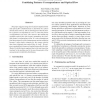Free Online Productivity Tools
i2Speak
i2Symbol
i2OCR
iTex2Img
iWeb2Print
iWeb2Shot
i2Type
iPdf2Split
iPdf2Merge
i2Bopomofo
i2Arabic
i2Style
i2Image
i2PDF
iLatex2Rtf
Sci2ools
ICPR
2008
IEEE
2008
IEEE
Structure from Motion: Combining features correspondences and optical flow
This paper suggests using discrete feature displacements and optical flow simultaneously to determine the camera motion and its velocity. This is advantageous when the number of feature correspondences is low or when the feature correspondences are noisy. The reason is that usually the available optical flow data largely outnumbers the available feature correspondences data. It is also advantageous from the perspective of the instantaneous motion estimation because it gives better estimates for the camera velocity than those obtained from optical flow by itself. We propose a probabilistic framework capitalizing on the this idea. Monte-Carlo filtering is employed due to the non-linearities involved in the problem and to the non-Gaussianity of the measurements’ probability distributions.
Computer Vision | Discrete Feature Displacements | Feature Correspondences | ICPR 2008 | Optical flow |
Related Content
| Added | 30 May 2010 |
| Updated | 30 May 2010 |
| Type | Conference |
| Year | 2008 |
| Where | ICPR |
| Authors | Adel H. Fakih, John Zelek |
Comments (0)

